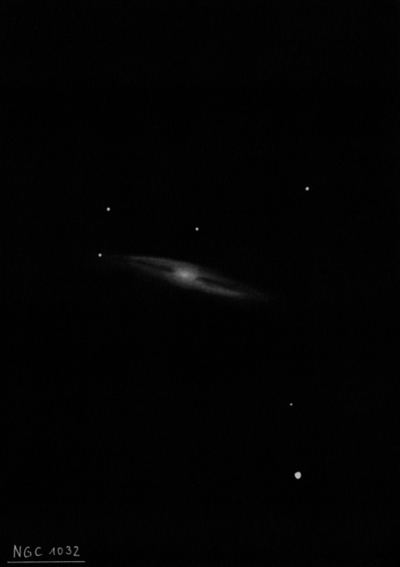
William Herschel discovered NGC 1032 = H II-5 = h246 on 18 Dec 1783 (early sweep 47) and noted "vF, S, like a small comet, 3/4? above Delta Ceti." On 7 Nov 1785 (sweep 470), he called it "the nebula in the quartile. It is not quite R, but lE having vF rays sp and nf." His summary description (from 8 sweeps) reads "pB, S, lE, bM." This was first object WH found with the telescope moving vertically only and using reference stars as they passed through the eyepiece. NGC 1032 was his 10th overall deep sky discovery (according to his internal numbering). LdR's 1861 publication mentions "Spirality suspected".
200/250mm - 8" faint, small, very elongated WSW-ENE, weak concentration. Four mag 13 stars to north including one 1.8' NE.
400/500mm - 17.5" (10/29/94): fairly bright, fairly large, very elongated 4:1 WSW-ENE, 2.5'x0.6'. Dominated by a bright core which is broadly concentrated and contains a faint stellar nucleus. The extensions are smooth and unconcentrated. A mag 12.5-13 star is at the ENE edge 1.4' from the center and two mag 13 stars are along the north side (1.8' NE and 1.3' NNW of center) forming a right triangle.
900/1200mm - 48" (10/26/11): at 385x and 488x appears very bright, large, very elongated 4:1 WSW-ENE, 3.0'x0.8'. Well concentrated with a prominent, bulging oval core that brightens towards the center and long, thin, fainter tapering extensions that dim at the tips. A mag 13 star is at the tip of the ENE extension. The visual treat, though, is a razor thin dust lane that clearly bisects the large central buge. As the much fainter extensions start to taper down, the dust lane loses contrast and disappears towards the ends.
Notes by Steve Gottlieb